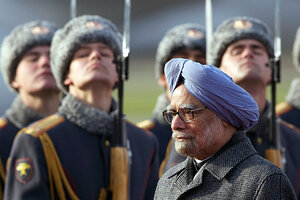India and China to ink a border deal: Will it ease strained ties?
Indian Prime Minister Manmohan Singh - under fire at home for being weak on China - will sign a cooperation pact with Beijing. He's trying to tackle a growing trade deficit with China as well.

Indian Prime Minister Manmohan Singh reviews the honor guard upon his arrival, at the Government Airport Vnukovo-2 outside Moscow, Sunday, Oct. 20, 2013. Singh's visit to Beijing on Tuesday aims at tackling two of the thorniest snarls in India-China ties – increasingly tense border disputes and a growing trade imbalance.
Alexander Zemlianichenko/AP
New Delhi
Indian and Chinese diplomats are racing to finalize negotiations over a border defense cooperation pact as Prime Minister Manmohan Singh arrives in Beijing for a visit aimed at tackling two of the thorniest snarls in India-China ties – increasingly tense border disputes and a growing trade imbalance.
The border agreement – expected to be signed Wednesday – would be a major confidence building measure between the world’s two most-populous nations after a three-week standoff at the border earlier this year.
“The two countries already have mechanisms to prevent tension on the disputed border but this agreement could immensely enhance those measures,” says Alka Acharya, professor of Chinese Studies at the Jawaharlal Nehru University in New Delhi. Advance warnings of border patrols and greater real-time communication are among those measures, he says.
India and China share a disputed 2,500-mile long border stretching from India’s extreme north in Ladakh to Arunachal Pradesh, known as the Line of Actual Control, in India’s northeast.
In May, just before the new Chinese premier Li Keqiang's visit to New Delhi, India accused China's People's Liberation Army of intruding six miles into Indian territory and setting up a camp, prompting Indian troops to set up their own nearby camp in response. The standoff lasted three weeks, ending when India removed military structures the Chinese perceived as threatening.
The Indian Prime Minister's visit – his final trip before a new prime minister is elected this spring – also comes at a time when the opposition is criticizing Dr. Singh for being “weak on China.”
Historical distrust
India and China fought a brief border war in 1962 and have not been able to resolve the dispute since. China claims 35,000 square miles of Indian-administered territory in the east – which is all of India's state of Arunachal Pradesh – and India claims 14,600 square miles of Chinese-held territory in the Northern Ladakh region.
Tensions flared up lately because both sides have been upgrading military infrastructure near the Line of Actual Control. Some analysts doubt if the agreement to be signed this week is meant in any seriousness to resolve the border dispute, or if the agreement will be a temporary patch to hold over economic ties.
“In this case there is no indication that India and China are serious about resolution or negotiations. The focus is on maintaining the de facto status quo without having the political will to turn the current line of control into international boundary,” says Dibyesh Anand, associate professor of international relations at London's University of Westminster and an expert on China-India relations.
Trade deficit
Despite the border dispute, India and China have steadily increased trade ties. China is India’s largest trading partner, and India-China bilateral trade stood at $66 billion in 2012, down from $74 billion the previous year.
Yet India's trade deficit with China has increased from $1 billion to $40 billion over the past decade, according to data from India's Ministry of Commerce. The deficit, paired with a decreased appetite for Indian exports of raw materials such as iron ore, are a matter of grave concern for India.
To allay Indian concerns about the growing trade deficit, China has proposed setting up a Chinese Industrial Park in India, which would help attract Chinese investors.
Singh told Chinese-state run Xinhua news agency in a written interview in advance of his Beijing visit that India “welcome[s] the idea” of an industrial park and that Chinese officials had been shown a few potential sites for setting up such a park.
Some economic experts think India's concerns about the trade imbalance with China are a distraction from tackling needed structural reforms: "Instead of worrying about the trade deficit with China, India needs to improve the investment climate in India in general so that all foreign investors, including the Chinese, look at India as an opportunity," says Indian economist Surjit Bhalla, president of Oxus Investments, a New Delhi-based economic consultancy firm.
"Developing countries often have trade deficits. What they should worry more about is their growth, in which India has lately been faltering," Mr. Bhalla says.
The two Asian giants aim to boost bilateral trade to $100 billion by 2015. While India wants Chinese investment in its economy, it also fears its security implications, which has meant operational delays in basic matters like granting visas.
“There are most certainly some security concerns holding back India's acceptance of Chinese investment, particularly in telecom and telecom investment, but these can be allayed by building in requisite checks and balances in contracts. The whole world is trading with China and getting Chinese investments, and so should we,” says Mr. Acharya.

